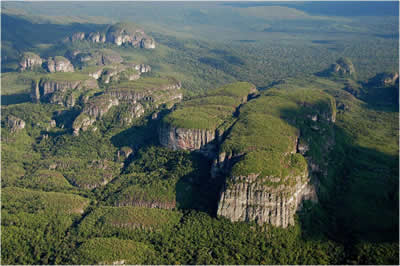Possible and Sustainable Amazonia
 |
| Photo: Parque Chiribiquete/Álvaro Gaviria - Parques Nacionales Naturales de Colombia © |
The Colombian Amazonia, with an extension of 476,000 km2 and located at the Northwestern end of the basin, constitutes 6.4% of the total Amazonian biome and 42% of the national territory. It is a highly relevant geo-political region due to its environmental and ecological importance, and due to the fact that it is a cross-border region with a rich cultural heritage.
The Colombian Amazonia is home to abundant natural and environmental resources. Its connection to the Andes is one of its greatest sources of biophysical abundance. Additionally, there are 50 indigenous peoples living within its borders, who have ancestral knowledge on forest management and water sources. With its more than 40 million ha of standing forest, it is also an important carbon pool.
Nevertheless, the Amazonian region faces major threats such as the exploitation of mineral and oil deposits, illegal mining, illegal farming, human settlement and deforestation, which between 2005 and 2010 amounted to 80,000 ha per year.
The damage caused might be irreversible and could have a significant impact in the medium and long term. This is why the Economic Commission for Latin America and the Caribbean (ECLAC), under the coordination of Juan Carlos Ramírez, Director of the Organization in Colombia, has guided a study entitled Amazonia posible y sostenible (Possible and sustainable Amazonia), supported by the Gordon and Betty Moore Foundation and the national institutions Parques Nacionales Naturales de Colombia and Patrimonio Natural, Fondo para la Biodiversidad y Áreas Protegidas.
Amazonia posible y sostenible sets forth the elements to define a national vision of the Amazonia that guides differentiated public policy making for sustainable development in the region.
First, the study highlights the understanding of the Amazonia as an identifiable and diverse region where national policies could be put into practice. There is no recipe that can be applied indiscriminately to the whole of its territory, as its subregions have different social, cultural, environmental and economic conditions, states the study.
According to the ECLAC document, the Colombian Amazonia can be analyzed in various scenarios, from perspectives and for periods that result in a wide variety of future prospects. Depending on what the country pursues in mining, conservation and the agricultural frontier – among other sectors – the scenario analysis shown in the study allows for promoting a collective vision on what the country plans for this region.
According to Amazonia posible y sostenible, the contribution of the environment and biodiversity to social welfare is underrated due to a lack of knowledge on these issues. Conceiving the Amazon Rainforest as a source of wealth and not as a hindrance to development requires shifts in the conventional paradigm and long-term efforts.
In order to achieve sustainable regional development, the creation and application of knowledge, the cultural ownership of the peoples living in that territory, dialogue and ancestral and modern knowledge exchange are critical, according to the study.
If preserving natural capital is a national goal, national resources must be earmarked to develop knowledge and carry out research, to regulate the utilization of natural resources, to design and institutionalize management, and to develop viable income alternatives for peoples in the area through an appropriate exploitation of natural resources, adds the ECLAC study.
The study Amazonia posible y sostenible concludes that the main public policy for the Amazonia is the preservation of resources and ecosystems, as there is no development strategy justifying its destruction. Practically no Colombian would think of him/herself without the Amazonia, claims the study.
More SUBREGIONAL/OFFICES
What did Mexico and Canada do for
recovering from the 2008-2009 crisis?
Health Tourism, a New Market for Latin America and the
Caribbean
| Conceiving the Amazon Rainforest as a source of wealth and not as a hindrance to development requires shifts in the conventional paradigm and long-term efforts. | |
| In order to achieve sustainable regional development, the creation and application of knowledge, the cultural ownership of the peoples living in that territory, dialogue and ancestral and modern knowledge exchange are critical. | |